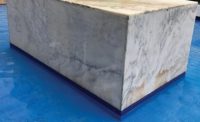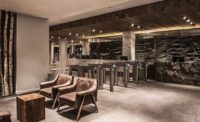Perched high on the hillside of San Rafael, CA, Case Study House #26 was the first of its kind in the San Francisco Bay area. Designed by architect Beverley David Thorne in 1963, it was an experimental project to build a steel-framed house on a steeply sloping site and to demonstrate how to construct it without tearing up the natural terrain in the way usually required by conventional building. In 2015, the historic home was purchased by architect, Cord Struckmann, who undertook a thoughtful remodel that included replacing the floor finishes in the common areas. He ultimately decided large-format tiles would fit the style of the house, while providing sustainability.
“Previously covered with carpet and vinyl tile, the project required the careful selection of a durable material that could also maintain the home’s design integrity,” he said. “This led to the selection of the Concrete line, [by Italian tile manufacturer Gigacer], which matched the mid-century modern aesthetic of the house. The minimalist large-format tiles provide the appropriate background to the modernist interiors, unifying the common areas and elevating the role of the floor in the space.”
Struckmann explained almost everything in the Case Study House #26 is still original, down to the light fixtures and bathroom vanities. “Only the cantilevered, concrete-on-wood deck was replaced with Trex decking in 2000 because it deteriorated to the point of being a safety hazard,” he said. “The wooden planter boxes outside the kitchen and bedroom windows rotted away and were taken down previously. But, overall, the previous owners took very good care of the house.”
The architect was driven by three design objectives when planning the renovation. They included better energy performance, because the carpet and underlayment on top of the radiant heating system essentially stopped the heat transmission into the room; longer lasting finishes and modern appliances for the kitchen. “Indoor barbecue grills are not for everyone, and the Formica wore off,” he said. “Though, the 1971 St. Charles steel kitchen cabinets were kept. They received a professional, automotive paint refinish. We worked with a car detailer, who sat up a professional body shop onsite.”
When it came to selecting the flooring material, Struckmann took his time to consider his options. “I actually looked at more products than I ever imagined -- visiting local dealers, international trade shows, etc.,” he said. “After narrowing it to ceramic tiles, we mocked up several samples to evaluate its appearance at different times of the day. It was critical to understand how the sun, coming in from all four directions over the course of the day, was reflected. The almost black Gigacer Concrete line had this beautiful balance between random subtle roughness and industrial perfection, which forms a wonderful dialog with the rational, white, steel structure.”
The floor tiles, which flow throughout the interior living space, measure 24 x 48 inches. “They underline the open floor plan concept,” said Struckmann. “The goal was to have as few joints as possible.”
After watching the first few tiles being installed, the architect explained it wasn’t necessary for him to spend much time onsite supervising. “Having a very detailed pattern plan avoided having unfortunate joints,” he said, adding that in addition to the tiles, a Ditra membrane and edge trims from Schluter-Systems were used for the floor installation.
Demolition and installation for the renovation was completed in three weeks. “The subfloor wasn’t as level as expected, but we had a good installer, Escarlata Tile, to float it at the right spots,” said Struckmann, who was pleased with the final result. “It is a wonderful product and installation. The client, and anyone who visits, is very impressed. I’m certain it will wear and age very well.” More images of the house are on www.casestudyhouse.com or Instagram (@casestudyhouse26).
|
Case Study House #26 San Rafael, CAOriginal Architect: Beverley David Thorne |








